Shows
18th Biennale of Sydney, “all our relations”


The 18th edition of the Biennale of Sydney (BoS), titled “all our relations,” crept into town in late June with very little fanfare as the laid back artistic directors, indigenous Canadian Gerald McMaster and Catherine de Zegher from Belgium, delivered their utopian vision of contemporary art practice that has the power to connect communities, foster collaboration, create dialogue and, it seems, cure the world’s ills.
This is the first time in the Biennale’s 39-year history that a curatorial duo has held the reins and one wonders if collaboration here might be a euphemism for compromise. What might have been a juggernaut in the hands of one artistic director—one thinks of the previous BoS in the hands of David Elliott or the stimulating challenges of the 2008 edition presented by Carolyn Christov-Bakargiev, both which achieved record breaking crowds—here proves to be a show that limps along as it explores an at times dense intellectual premise.
More than 220 works by over 100 artists from Australia, New Zealand, the Asia-Pacific, the Americas, Europe, South Africa and the Middle East, were displayed across several of Sydney’s premier art venues. The Museum of Contemporary Art Australia (MCA)—which since unveiling its expansion earlier this year has added the country’s name to its official title—continues its commitment to the Biennale, as does the Art Gallery of New South Wales (AGNSW), Pier 2/3 at Walsh Bay and Cockatoo Island, in the middle of Sydney Harbour.
While it would be unkind to say much of the work on show is lackluster, there are certainly many works that labor under the artistic directors’ conceptual framework. Many of the artists have obviously worked hard to fit the brief, with apparently 70 percent of the BoS budget having been spent on new commissions. One suspects that visitors likewise will have to work hard if they want to understand or engage with the show’s dialectical framework. Yet, there remain a number of works that stand out at each of the venues.
At the AGNSW senior Australian artist John Wolseley, seems to have re-invented himself at the age of 74, with a tour de force in what is his first appearance at the BoS. His Flight of Ventifacts: Mallee (2006–12) comprises sheets of heavy sketching paper that have been exposed to months of open air weather conditions in open scrub close to where he lives in the southern state of Victoria, thus taking on a sculptural hardness. Spread across several spaces in the AGNSW’s Yiribana Gallery for Aboriginal and Torres Straight Islander art, the paper twists and turns with feral ferocity. In fact, gallery cleaners have twice attempted to remove sheets thinking they were rubbish, much to Wolseley’s amusement.
Wolseley’s work possesses an aesthetic finesse that dominates the only other Biennale exhibit in the Yiribana Gallery, that of brutally direct indigenous collective Postcommodity’s Do You Remember When? (2009). For this, a one-meter-square slab of terrazzo has been removed from the floor, exposing the red earth beneath, to become a metaphorical portal celebrating indigenous intervention. The removed slab is up-ended on a pedestal like a mute but confronting stela, a gesture of indigenous defiance.
The AGNSW’s Major Exhibitions Gallery rather unkindly houses 30 or so other BoS works, which suffer from being shoehorned into the space. For example, two large video projections—one by Dutch artist Guido van der Werve, Nummer Acht, everything is going to be alright (2007), in which a solitary figure walks in front of an ice breaker before an expanse of ice, and the other, Steadfast (2009), by American Phil Hastings, showing a bilious ocean—would both benefit from more space to appreciate their meditative qualities and subliminal presence.
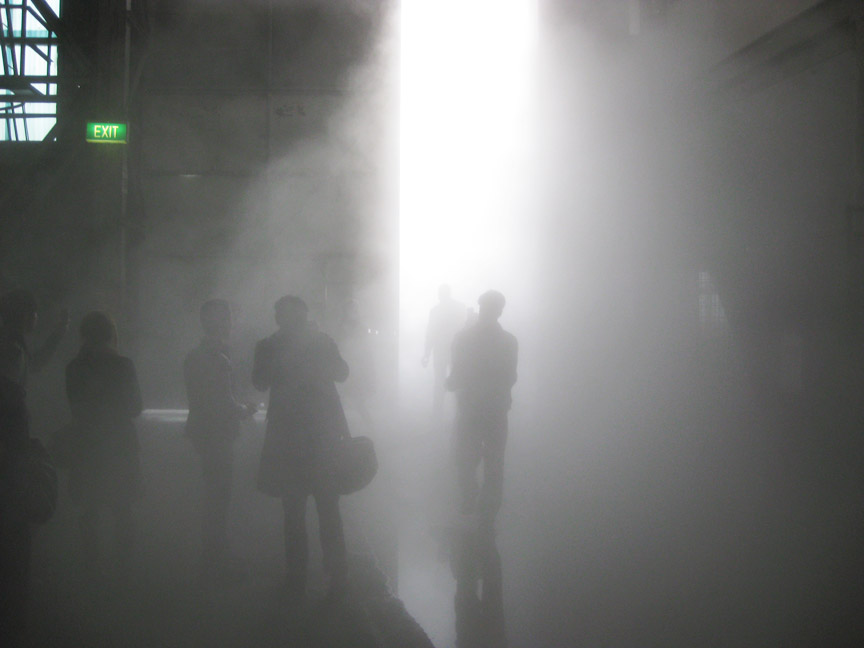
Nipan Oranniwesna’s City of Ghosts (2007–12)—a several-meter-square topographical map of an anonymous city made from baby powder—while being perhaps the most impressive work in the gallery is so poorly lit that it initially appears like a dull gray expanse, void of detail. Intentionally or not, the poor lighting does lend a revelatory atmosphere to viewing in this case. Oranniwesna’s work, in which one heavy sneeze would wipe out several imaginary suburbs, is a succinct comment on the fragility of the constructs in which most of us live.
The relatively poor organization at the AGNSW leaves one with the impression of a rather disparate collection show rather than that of a biennale predicated on an intellectual premise.
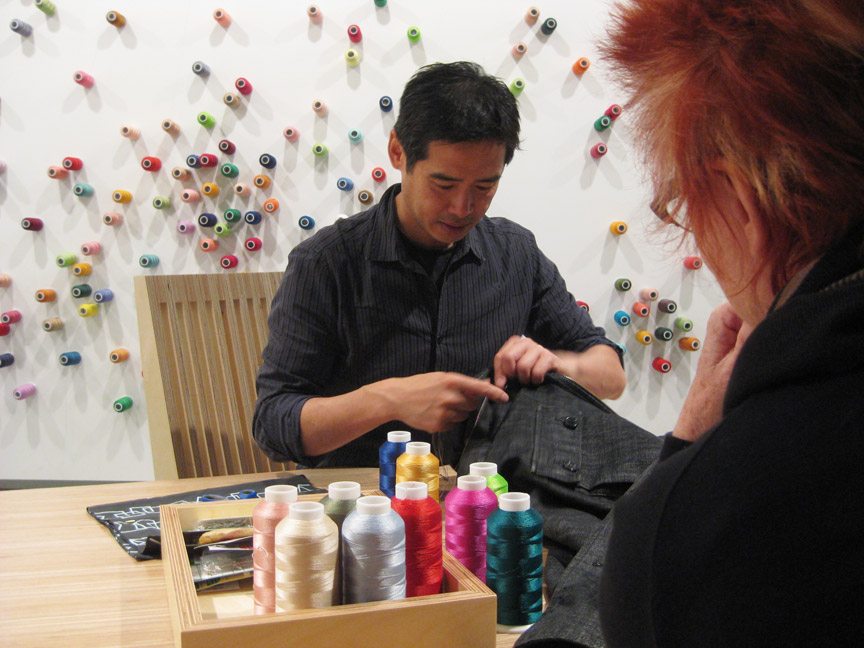
Three works dominate the MCA, which again devotes major gallery space to the Biennale. In the six-meter-high gallery of the new Mordant Wing, Pinaree Sanpitak’s installation, Anything Can Break (2011), consists of hundreds of gray origami cubes and blown glass “clouds,” modeled on breasts, suspended from the ceiling. With 16 musical components that are triggered as visitors walk beneath the “clouds” a cacophony of sound inevitable fulfils the curatorial brief of participatory engagement.
In the adjoining gallery, New York-based Taiwanese artist, Lee Mingwei, works on his quietly reflective performative installation, The Mending Project (2009). Here, a collaborative process quietly goes about its business as Lee sits at a table repairing clothes brought in by visitors, who must leave the repaired garments on display until the end of the exhibition. Conversing with visitors as he sews, the repairs are carried out in rainbow-colored threads, skeins of which are mounted on two adjacent walls, forming a vivid pattern.
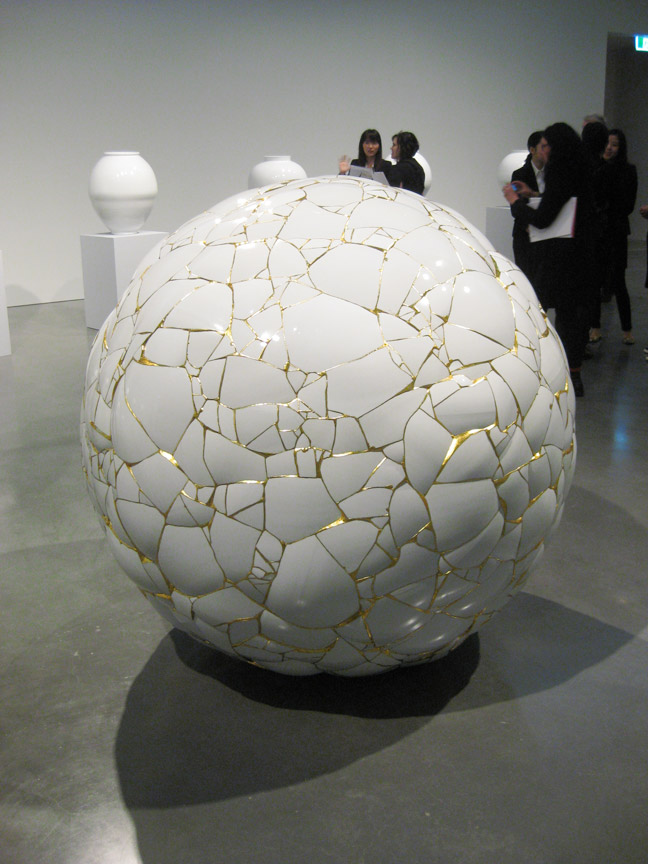
Korean artist Yeesookyung’s Translated Vase-the Moon (2012), is a giant white sphere made from shards of broken porcelain, joined with 24-karat gold. It sits beautifully alongside Korean master potter Park Young-Sook’s white moon jars. In what is a perfect and unforced collaboration with Park, Yeesookyung recovers fragments of jars that have shattered in the kiln and translates them into other geometrical forms. The relationship here between form and gallery space is an achievement that the AGNSW would do well to emulate.
Since the introduction of Cockatoo Island into the BoS repertoire of venues three editions ago the island has become synonymous with spectacle. It doesn’t disappoint this year with visitors immediately being enveloped in the disorientating clouds of Fujiko Nakaya’s fog installation at the entrance to the turbine hall. Inside, New Zealander Peter Robinson’s enormous installation, Gravitas Lite (2012), made from 102,410 fragile chain links of white polystyrene foam took 12 volunteers five weeks to assemble. The work reaches up to and over the building’s infrastructure in a display that is nothing if not pure audacity. Robinson explained the work to AAP, as an exploration of the relationships of materials, perhaps referring to the light, white polystyrene and the rusty, metal factory space that it fills.
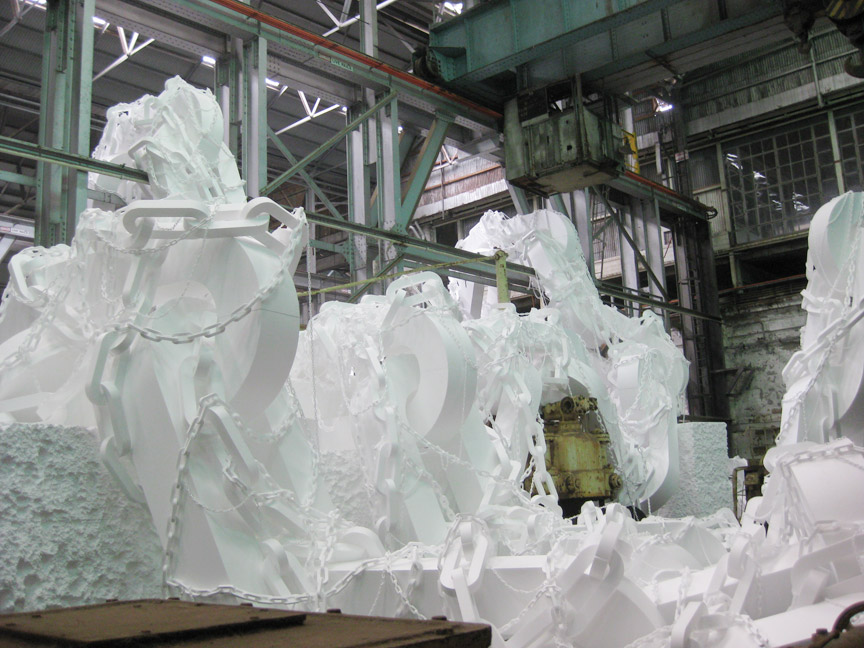

Canadian Cal Lane tackles the vastness of the turbine hall with a work that is about memory, the passage of time and transformation, where the impermeable elements of steel and sand combine in a piece of transient fragility. Originally a welder by trade, Lane makes finely cut patterns in steel for Sand Lace (2012), in which a steel shipping container is engraved until it takes on the form of a finely cut filigree stencil which is mirrored by similar patterns created from red sand and which spread across the floor of the cavernous turbine hall. Each carpet size "sand stencils" is based on a delicately patterned tablecloth that was given to her parents as a wedding gift 50 years ago this June.
Fellow Canadian Philip Beesley’s Hylozoic Series: Sibyl (2011) is an immersive installation that encourages visitors to touch the hundreds of thousands of custom-made components—chains of glass vessels, feathers, miniature computers, proximity detection sensors for example—that form diffuse clouds of glowing light. Responding to touch, the installation vibrates, glows and ripples, emitting whispering sounds as visitors move through its seemingly interstellar space until the installation seems to take on a life of it own.
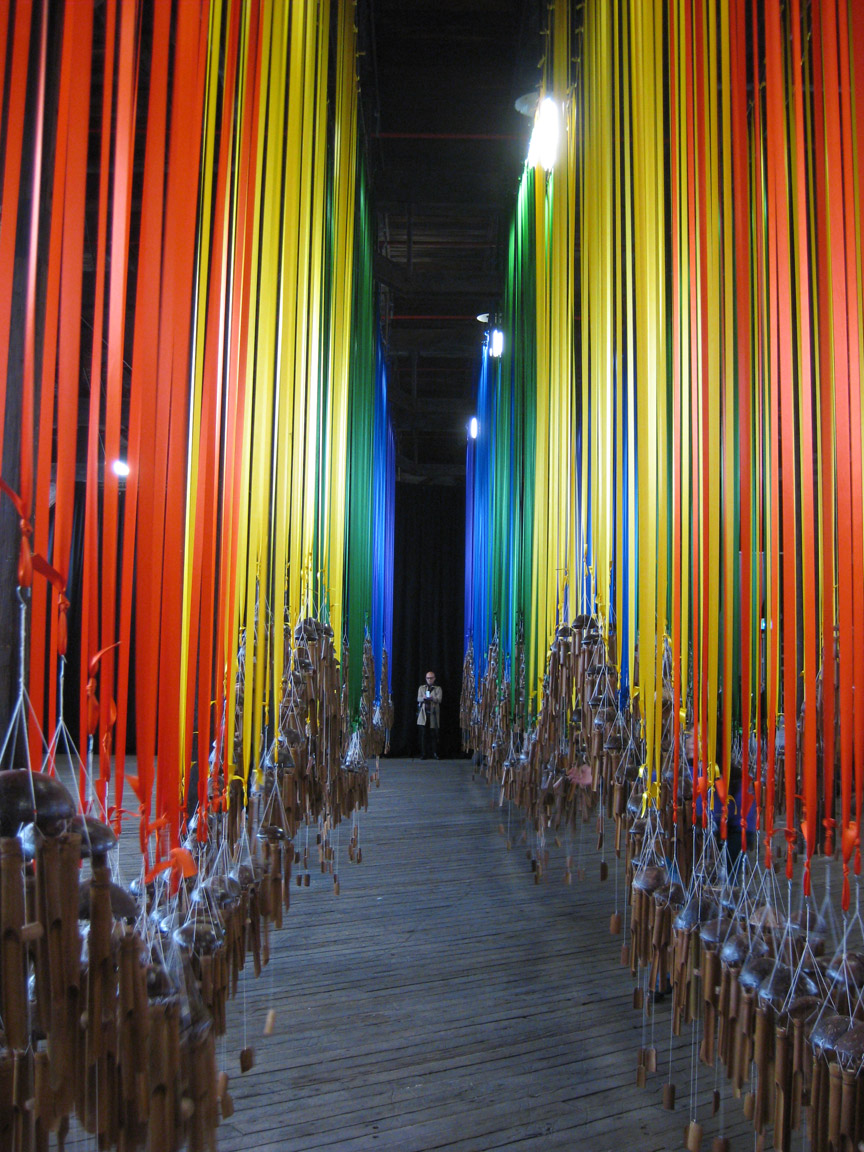
In the cavernous hall of the heritage-listed Pier 2/3 at nearby Walsh Bay, New Zealander Tiffany Singh has created a certain crowd-pleaser with Knock On the Sky Listen To The Sound (2011), in which hundreds of wooden wind chimes hang in rows from myriad long colored ribbons. The chimes are designed to be taken home by visitors, decorated and then returned, to be reintegrated into the installation. Yet, Singh admitted to AAP that the chimes have a disturbing tendency to disappear. Such is a collaborative process that, while it certainly won’t cure any of the world’s ills, is sheer fun all the same.
As an exhibition one can’t help but feel that the 18th Biennale of Sydney needs to escape from its rigid intellectual framework and the curator’s somewhat obvious premise, that evolving art practice can free us all from the enslavement of history and lead us toward a state of artistic enlightenment so long as we embrace collaboration and dialogue.
Fortunately, but perhaps more by accident than design, there is much on show that will reward visitors who would be well advised to ignore the pretensions of the catalog essays and allow the art to work on a visceral rather than intellectual level.
The Biennale of Sydney runs until September 16.







